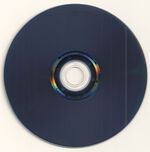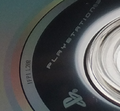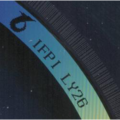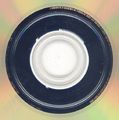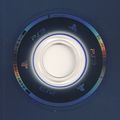Disc Identification/Serialization Data: Difference between revisions
m (→Angular Marks) |
m (Just some Typos and wikify) |
||
| Line 1: | Line 1: | ||
<div style="float:right">[[File:CUSA-00002.jpg|150px|thumb|left|Picture of the bottom side from a PS4 Game Disc]]</div> | <div style="float:right">[[File:CUSA-00002.jpg|150px|thumb|left|Picture of the bottom side from a PS4 Game Disc]]</div> | ||
The Identification & Serialisation Data from a PS4 [[Game Titles|Game Title]] contains several Information, which you can find not only on any Game Disc pressed for the PS4, but also similar for any PS3 or any other Console-based Disc Game and other Media pressed on CD, {{G|DVD}} and Blu-ray. | The Identification & Serialisation Data from a PS4 [[Game Titles|Game Title]] contains several Information, which you can find not only on any Game Disc pressed for the [[Console Information|PS4]], but also similar for any PS3 or any other Console-based Disc Game and other Media pressed on CD, {{G|DVD}} and Blu-ray. | ||
== Source Identification Code == | == Source Identification Code == | ||
The Source Identification Code (SID-Code) can be found on almost all pressed optical discs worldwide since 1994, originally planned as a piracy safeguard, but it's also used | The Source Identification Code (SID-Code) can be found on almost all pressed optical discs worldwide since 1994, originally planned as a piracy safeguard, but it's also used for acceptance sampling. It contains two Codes, one Mould Code and one Mastering Code (hidden on PlayStation 4 Game Discs with multiple {{PS4}} logos). Each Code consists the digits "IFPI" (named by the '''I'''nternational '''F'''ederation of the '''P'''honographic '''I'''ndustry) followed by a four or (less often) five digit code (commencing with the letter "L"). These two codes can be used to trace the location from a manufacturing or mastering plant where the disc got pressed. These codes are located in the inner ring from any optical disc, outside the data section. | ||
=== Mastering plant SID Codes === | === Mastering plant SID Codes === | ||
{| class="wikitable sortable" | {| class="wikitable sortable center" | ||
|- | |- | ||
! style="background-color:#FFFFFF; color:#000000;" |'''Region''' | ! style="background-color:#FFFFFF; color:#000000;" |'''Region''' | ||
| Line 16: | Line 16: | ||
! style="background-color:#FFFFFF; color:#000000;" |'''Mastering plant''' | ! style="background-color:#FFFFFF; color:#000000;" |'''Mastering plant''' | ||
! style="background-color:#FFFFFF; color:#000000;" |'''[[Countries|Country]]''' | ! style="background-color:#FFFFFF; color:#000000;" |'''[[Countries|Country]]''' | ||
! style="background-color:#FFFFFF; color:#000000;" |'''Branch''' | |||
! style="background-color:#FFFFFF; color:#000000;" |'''Remark''' | ! style="background-color:#FFFFFF; color:#000000;" |'''Remark''' | ||
|- | |- | ||
| rowspan="5" | Europe || rowspan="2" | CD || PSX || IFPI 94** || IFPI L551 to IFPI L560 | | rowspan="5" | Europe || rowspan="2" | CD || PSX || IFPI 94** || IFPI L551 to IFPI L560 || Sony DADC Austria AG || {{flag|AT}} || [http://en.wikipedia.org/wiki/Thalgau Thalgau], near Salzburg || Invisible Mastering Code (complete disc is blackened) | ||
|- | |- | ||
| rowspan="2" | PS2 || ? || rowspan="2" | | | rowspan="2" | PS2 || ? || ? || ? || ? || ? || rowspan="2" | Hidden Mastering code(s) with multiple PlayStation(R)2 letterings | ||
|- | |- | ||
| DVD || IFPI L5** || Sony DADC Austria AG || {{flag|AT}} || [http://en.wikipedia.org/wiki/Anif Anif], near Salzburg | | DVD || IFPI L5** || ? || Sony DADC Austria AG || {{flag|AT}} || [http://en.wikipedia.org/wiki/Anif Anif], near Salzburg | ||
|- | |- | ||
| rowspan="2" | Blu-ray || PS3 || rowspan="2" | IFPI LY** || IFPI LZ08 | | rowspan="2" | Blu-ray || PS3 || rowspan="2" | IFPI LY** || rowspan="2" | IFPI LZ08 || rowspan="2" | QOL Fi Group || rowspan="2" | {{flag|FR}} || rowspan="2" | [http://fr.wikipedia.org/wiki/Vernouillet_(Yvelines) Vernouillet (Yvelines)], near Paris || Hidden Mastering code with multiple PS3 logos or PLAYSTATION(R)3 letterings | ||
|- | |- | ||
| PS4 || | | PS4 || Hidden Mastering code with multiple {{PS4}} logos | ||
|} | |} | ||
| Line 43: | Line 44: | ||
== Burst cutting area == | == Burst cutting area == | ||
The (narrow) burst cutting area ((N)BCA) can be used for adding additional information such as serial numbers or any | The (narrow) burst cutting area ((N)BCA) can be used for adding additional information such as serial numbers or any Information about the manufacturing process etc. The BCA-code is written using a [http://en.wikipedia.org/wiki/Nd:YAG_laser Nd:YAG laser] and can be also used as a security measure to avoid illegal copies from a pressed disc (for example on game discs for the Nintendo GameCube, Wii & Wii U). Therefore it isn't possible to reproduce/copy the BCA with a standard optical disc drive running on a PC/Laptop. | ||
* Location: inner ring, inside data section | * Location: inner ring, inside data section | ||
| Line 54: | Line 55: | ||
=== PIC Zone === | === PIC Zone === | ||
This (pre-recorded) PIC zone, which is included within the BCA (Data size: 0x73 bytes), contains general | This (pre-recorded) PIC zone, which is included within the BCA (Data size: 0x73 bytes), contains general Information about the disc that includes, but is not restricted to: | ||
* Physical media class and version, | * Physical media class and version, | ||
| Line 79: | Line 80: | ||
== Angular Marks == | == Angular Marks == | ||
<div style="float:right">[[File:Russian BD-ROM C3.jpg|200px|thumb|left|Screenshot while reading a pressed BD-ROM movie with Region 3. It tries to read the Sectors but it will got stock at the Angular Marks (Bad Sector(s) found!). So it forces the Drive to read | <div style="float:right">[[File:Russian BD-ROM C3.jpg|200px|thumb|left|Screenshot while reading a pressed BD-ROM movie with Region 3. It tries to read the Sectors but it will got stock at the Angular Marks ("'''Bad Sector(s) found!'''"). So it forces the Drive (if supported) to read those Sector(s) in the RAW file system ("'''Modified volume recognition sequence!'''") instead of UDF, with success.]]</div> | ||
Angular Marks are also a security measure to avoid piracy. It | Angular Marks are also a security measure to avoid piracy. It makes the difference that these Marks were located in the data area of a disc (outside the BCA). It works similar to the old Bad Sector copy protection, were the {{G|CD-ROM}} got pressed with zero-filled Physical Sector Numbers, which were unreadable for some very old outdated optical disc drives without RAW writing function. Instead, the sectors are readable (error correction will fix the angular marks), but a special feature of the DVD controller allows recovering the bit-exact position and size of the laser mark. The result is then stored signed in the BCA, so that the reader can validate it. Since the laser marks are written after producing the discs, the marks cannot be as accurately as required to pass a given BCA. This method is used on the Nintendo Gamecube<!--// and this is not GC devwiki.com ;)//-->, for example. This can be circumvented by placing strings of zeros in the actual bitstream, which - to the reader - look identical to an angular laser mark. | ||
It is known<ref>see http://psdevwiki.com/ps3/ - AACS specifications and BD patents</ref> that Sony (Pictures Entertainment) use these Marks for their Blu-ray movies to avoid illegal copies (which is easy to bypass), but there are no information about the applicability on PS3/PS4 game discs pressed on BD-ROM. | It is known<ref>see http://psdevwiki.com/ps3/ - AACS specifications and BD patents</ref> that Sony (Pictures Entertainment) use these Marks for their Blu-ray movies to avoid illegal copies (which is easy to bypass), but there are no information about the applicability on PS3/PS4 game discs pressed on BD-ROM. | ||
| Line 93: | Line 94: | ||
{{reflist}} | {{reflist}} | ||
* [http://debugmo.de/2008/11/anatomy-of-an-optical-medium-authentication/ Anatomy of an Optical Medium Authentication (Part 1)] | * [http://debugmo.de/2008/11/anatomy-of-an-optical-medium-authentication/ Anatomy of an Optical Medium Authentication (Part 1)] | ||
== ROM Mark == | == ROM Mark == | ||
Revision as of 21:36, 20 January 2014
The Identification & Serialisation Data from a PS4 Game Title contains several Information, which you can find not only on any Game Disc pressed for the PS4, but also similar for any PS3 or any other Console-based Disc Game and other Media pressed on CD, DVD and Blu-ray.
Source Identification Code
The Source Identification Code (SID-Code) can be found on almost all pressed optical discs worldwide since 1994, originally planned as a piracy safeguard, but it's also used for acceptance sampling. It contains two Codes, one Mould Code and one Mastering Code (hidden on PlayStation 4 Game Discs with multiple ![]() logos). Each Code consists the digits "IFPI" (named by the International Federation of the Phonographic Industry) followed by a four or (less often) five digit code (commencing with the letter "L"). These two codes can be used to trace the location from a manufacturing or mastering plant where the disc got pressed. These codes are located in the inner ring from any optical disc, outside the data section.
logos). Each Code consists the digits "IFPI" (named by the International Federation of the Phonographic Industry) followed by a four or (less often) five digit code (commencing with the letter "L"). These two codes can be used to trace the location from a manufacturing or mastering plant where the disc got pressed. These codes are located in the inner ring from any optical disc, outside the data section.
Mastering plant SID Codes
| Region | Disc type | Platform | SID-Mould code | SID-Mastering code(s) | Mastering plant | Country | Branch | Remark |
|---|---|---|---|---|---|---|---|---|
| Europe | CD | PSX | IFPI 94** | IFPI L551 to IFPI L560 | Sony DADC Austria AG | Thalgau, near Salzburg | Invisible Mastering Code (complete disc is blackened) | |
| PS2 | ? | ? | ? | ? | ? | Hidden Mastering code(s) with multiple PlayStation(R)2 letterings | ||
| DVD | IFPI L5** | ? | Sony DADC Austria AG | Anif, near Salzburg | ||||
| Blu-ray | PS3 | IFPI LY** | IFPI LZ08 | QOL Fi Group | Vernouillet (Yvelines), near Paris | Hidden Mastering code with multiple PS3 logos or PLAYSTATION(R)3 letterings | ||
| PS4 | Hidden Mastering code with multiple |
Gallery
References
Burst cutting area
The (narrow) burst cutting area ((N)BCA) can be used for adding additional information such as serial numbers or any Information about the manufacturing process etc. The BCA-code is written using a Nd:YAG laser and can be also used as a security measure to avoid illegal copies from a pressed disc (for example on game discs for the Nintendo GameCube, Wii & Wii U). Therefore it isn't possible to reproduce/copy the BCA with a standard optical disc drive running on a PC/Laptop.
- Location: inner ring, inside data section
- Radius: 1.2 mm (zone between 22.3 ±0.4 mm to 23.5 mm ±0.5 mm (single-layer), 21.0 ±0.4 mm to 22.2 mm ±0.5 mm (dual-layer))
- Data size: 12 bytes (minimum) to 188 bytes (maximum) (in steps of 16 bytes)
Sometimes blank recordable & rewritable discs (such as DVD-R/RW/RAM) uses also a BCA-code were information about the CPRM and other DRM-policies were stored.
A Pre-recorded Media Serial Number (PMSN) located inside the BCA can be stored on a Blu-ray Disc (but extremely unlikely on PS3/PS4 game discs because this was a part from the AACS copy protection).
PIC Zone
This (pre-recorded) PIC zone, which is included within the BCA (Data size: 0x73 bytes), contains general Information about the disc that includes, but is not restricted to:
- Physical media class and version,
- Physical address of the start of the Data Zone
- Physical address of the start of the outer zone (if this is a single layer media, this is the lead-out)
- Number of layers
- Recording Density
- Write power information
Gallery
References
- Standard ECMA-267 - 3rd Edition - April 2001
- Physical Format Specifications for BD-ROM White Paper - 6th Edition - October, 2010
- Advanced Access Content System (AACS): Blu-ray Disc Pre-recorded Book
Angular Marks
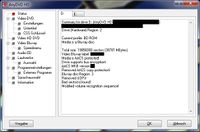
Angular Marks are also a security measure to avoid piracy. It makes the difference that these Marks were located in the data area of a disc (outside the BCA). It works similar to the old Bad Sector copy protection, were the CD-ROM got pressed with zero-filled Physical Sector Numbers, which were unreadable for some very old outdated optical disc drives without RAW writing function. Instead, the sectors are readable (error correction will fix the angular marks), but a special feature of the DVD controller allows recovering the bit-exact position and size of the laser mark. The result is then stored signed in the BCA, so that the reader can validate it. Since the laser marks are written after producing the discs, the marks cannot be as accurately as required to pass a given BCA. This method is used on the Nintendo Gamecube, for example. This can be circumvented by placing strings of zeros in the actual bitstream, which - to the reader - look identical to an angular laser mark.
It is known[1] that Sony (Pictures Entertainment) use these Marks for their Blu-ray movies to avoid illegal copies (which is easy to bypass), but there are no information about the applicability on PS3/PS4 game discs pressed on BD-ROM.
Gallery
References
- ↑ see http://psdevwiki.com/ps3/ - AACS specifications and BD patents
ROM Mark
Notes
It is unknown if any PS3/PS4 game discs contains a ROM Mark because these Marks were only in use when there were several Mastering plants who got the order to press identical DVD's and/or Blu-ray's (for example when one plant in Portugal and another one in Finland got the orders to press the same Blu-ray Movie with the same Languages and Subtitles for releasing in several European markets. Therefore it is like a copy protection between all Mastering plants and those are able to verify if there were some other (unlicensed) Mastering plants who reproduces a DVD and/or Blu-ray without permission, like on some Third World markets with illegal copies in China and so on). But it seems that there is only one Mastering plant for each Region who got the license to press PS4 Game Discs. As like, it would be redundant that PS4 Discs contains a ROM Mark.
So the ROM Mark can be also used as a security measure against piracy, which works together with AACS and already in use with several pressed Blu-ray movies. Of course it would be possible that the ROM Mark communicates with any other file(s) on a PS3/PS4 Game Disc, but with which one (EBOOT.BIN/INSTALL.PKG)? Therefore the following can be thought of as a general Information.
Information
ROM Mark or BD-ROM Mark is a serialization technology designed to make it more difficult for replication plants to do unlogged over-runs (being sold out the back door, without the copyright holder's knowledge) on a pressing.
Only licensed BD-ROM manufacturers have access to the equipment that can make these unique ROM Marks (physical-layer to store key cryptographic secrets).
Although every machine used to laser-cut a master disc is theoretically the same, the motor that spins the blank disc and moves the laser along a spiral track varies slightly in speed and precision. So if a digital marker is put in the middle of a recording, its physical position on the master disc - and every disc then pressed - will be a unique fingerprint of the cutting machine.
- location:
- length:
- sample:
Patents and references
- http://www.google.com/#q=rom+mark+patent
- Blu-ray and HD DVD Content Protection
- Blu-ray Disc Marking System Explained
- Blu-Ray Disc Copy Protection - Whitepaper October 2006
Trivia
If you got horny about the pictures from the bottom side of a PS4 Game Disk:
- CUSA-00002 (Killzone: Shadow Fall) JPG @ 4843x4915px TIF @ 11758x11933px
- CUSA-00128 (FIFA 14) JPG @ 3686x3633px TIF @ 12166x11990px
Generic
- Postscribed ID
- http://www.blu-raydisc.com/assets/downloadablefile/bd-romwhitepaper20070308-15270.pdf (including page 40 SID, page 41 BCA, page 45 PIC Zone)
- AACS specifications
- Patent 07278031 - Secure distribution of portable game software & img
- Thomson Patent:
- Optical disc with pre-recorded and recordable regions (A proposed alternative for CBA: disabled at factory, enabled at a point of sale)
| |||||||||||||||||||||||||||||||||||||||||||||
